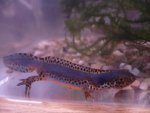MollyAttack
New member
- Joined
- Dec 3, 2010
- Messages
- 15
- Reaction score
- 1
- Points
- 0
- Location
- Illinois
- Country
- United States
- Display Name
- Molly
Hello there, I am narrowing down my search for my new companion and I am deciding between Alpine newts, an axolotl, or a Cynops cyanurus. I was looking at the care sheet for the alpines and they're gorgeous BUT I do have a question about their diet. I was reading that the juveniles eat bloodworms and various other worms but what about the adults? Will adult alpines still eat bloodworms and earthworms or not? They listed a couple foods for the adults, but unfortunately I cannot provide any of them for an alpine newt, though I can provide earthworms and bloodworms. Has anybody ever had any experience feeding those? Is it not good for them or do they turn their nose up at it? I'm just trying to figure out the best newt for my situation.
Thanks!
Thanks!


